Threaded Inline Heaters
Max temperature up to 1400ºF / 760ºC
Style A – Leak-proof design with sealed feedthrough, suitable for high-pressure systems
Style B – Flexible wire leads for general applications and moderate pressures
Power 1.6kW – 24kW, voltage 120–480V.

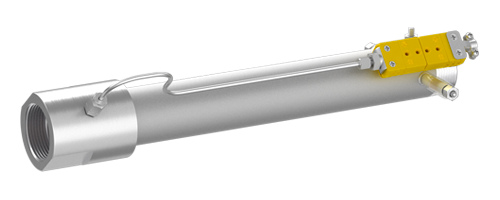
High-performance, leak-proof air heating solutions for industrial applications
The TUTCO SureHeat Threaded Inline Heater is engineered to provide precise, efficient, and reliable air heating for demanding industrial environments. Capable of reaching exhaust temperatures up to 1,400°F (760°C) and designed to withstand inlet pressures up to 150 PSI, this heater is ideal for applications that require rapid, high-temperature airflow in confined or challenging spaces. Its robust stainless steel construction, versatile NPT mounting options, and compatibility with digital temperature controllers make it a dependable choice for processes where accuracy, repeatability, and durability are critical.
Whether integrated into OEM machinery, production lines, or standalone systems, the Threaded Inline Heater delivers consistent, high-performance heat that outperforms conventional inline air heaters.
Discover which Threaded Inline heater is ideal for your application
Use the table below to determine the optimal Threaded Inline heater for your application, or contact TUTCO SureHeat to discuss specific process requirements and receive expert support.
Features & Benefits
- High-Temperature Performance: Achieves exhaust temperatures up to 1,400°F (760°C), suitable for processes like adhesive curing, plastic welding, and shrink wrapping.
- High-Pressure Capability: Rated for inlet pressures up to 150 PSI, making it suitable for compressed air systems and high-pressure applications.
- Durable Construction: Housed in a 304 stainless steel body, offering corrosion resistance and long-term durability.
- Versatile Mounting Options: Available in various NPT sizes (3/8", 1/2", 1-1/4", 2-1/2"), compatible with standard industrial piping systems.
- Compatibility with Digital Controllers: Designed to integrate seamlessly with digital temperature controllers featuring Type K thermocouple inputs, enabling precise temperature regulation.
Specifications
- Maximum Exhaust Temperature: Up to 1,400°F (760°C)
- Maximum Inlet Pressure: 150 PSI
- Material: 304 Stainless Steel
- Mounting Style: Threaded NPT (3/8", 1/2", 1-1/4", 2-1/2")
- Electrical Termination: Style A: Terminal Posts, Style B: Wire Leads
- Power Options: 1.6 kW to 24 kW
- Voltage Options: 170V, 240V, 480V
- Control Compatibility: Compatible with digital controllers with Type K thermocouple inputs
Style A vs. Style B: Choosing the Right Configuration
TUTCO SureHeat offers two configurations for the Threaded Inline Heater: Style A and Style B, each tailored to meet specific application requirements.
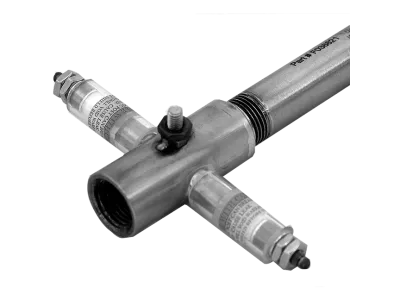
Style A: Leak-Proof Design for High-Pressure Systems
- Leak-Proof Power Feedthrough: Features high-pressure power feedthroughs, ensuring a sealed electrical connection that prevents air leakage, making it ideal for pressurized systems.
- Maximum Inlet Temperature: Supports inlet temperatures up to 900°F (482°C), suitable for high-temperature applications.
- Pressure Rating: Designed to withstand up to 150 PSI, accommodating high-pressure air systems.
- Electrical Termination: Equipped with nickel-plated terminal posts, providing a secure and reliable electrical connection.
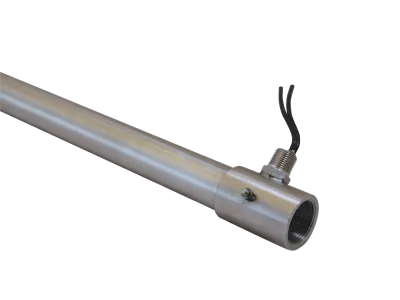
Style B: Flexible Wire Leads for General Applications
- Flexible Wire Leads: Comes with 12-inch flexible wire leads (12 AWG, fiberglass sleeved), offering ease of installation and flexibility in mounting.
- Maximum Inlet Temperature: Supports inlet temperatures up to 200°F (93°C), suitable for lower-temperature applications.
- Pressure Rating: Rated for up to 150 PSI, accommodating high-pressure air systems. Style B heaters leak a small amount of air through the wires.
- Electrical Termination: Features stranded wire leads, allowing for flexible installation options.
Industries & Applications
The TUTCO SureHeat Threaded Inline Heater is engineered for precision air heating in a wide range of industrial and OEM applications. Its high-temperature capability, robust pressure rating, and versatile mounting options make it suitable for both localized and high-volume process heating needs.
- Automotive & Transportation – Adhesive activation, panel bonding, heat forming, welding, testing, and simulation. Ensures strong, durable bonds in assembly processes and consistent heat for component testing.
- Aerospace & Defense – Composite curing, component testing, thermal simulations, de-icing systems, and other high-temperature processes where reliability and precision are critical.
- Plastic Processing & Packaging – Plastic welding, shrink fitting, forming, bending, sealing, and heat shrinking applications. Provides controlled heat for improved product quality and process efficiency.
- Electronics & Semiconductor – Solder reflow, wafer processing, quick drying, component sealing, and curing adhesives. Maintains uniform heat in sensitive manufacturing environments.
- Food & Beverage – Drying, sterilization, baking, coating, and shrink-wrapping processes. Supports consistent product quality while meeting hygiene standards.
- Medical & Pharmaceutical – Sterilization, packaging, lab testing, and other processes requiring precise, high-temperature air in controlled settings.
- Printing & Converting – Ink drying, laminating, coating, embossing, and shrink wrapping. Enhances production efficiency with accurate, repeatable heating.
- General Industrial & OEM Machinery – Hot air knives, small-scale curing, drying tunnels, and integration into custom machinery requiring high heat. Offers versatility for both standalone and integrated heating systems.
Notes
Threaded In-line thermocouple adapter material is 316 stainless steel Better resistance to oxidation at higher temperatures Type K thermocouple F206119 sold separately Use of other sensor types and mounting locations can result in heater damage Thermocouple mounting depth location is critical. Follow all mounting instructions. If replacing a Thermocouple, take note of the depth by measuring the distance to the compression fitting on the old Thermocouple. UL recognized, CE, RoHS
Make sure to properly mount the TC coupling so that the TC is slightly above the ceramic rod running through the center of the Serpentine™ heating element. The open end of the TC should be in the heated air stream. The inlet side of the heater is located closest to the power feed throughs. Installation orientation is critical. Positioning the heater in the wrong direction will cause damage. Like all Tutco SureHeat heaters, do not operate without the air on.
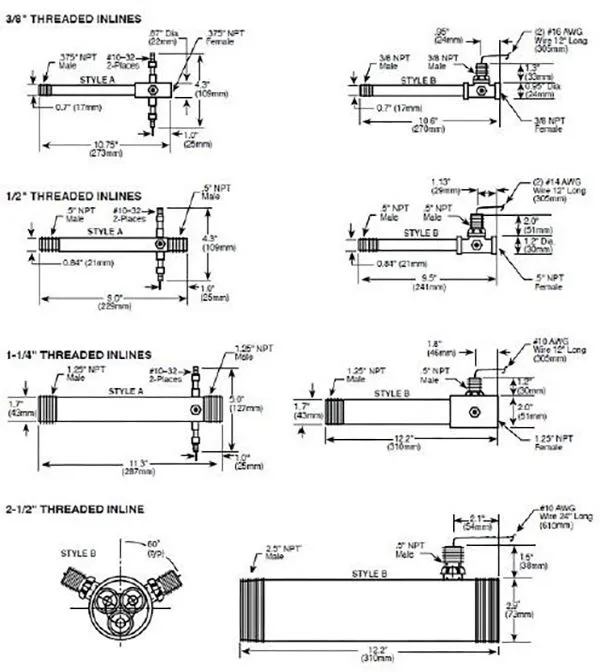
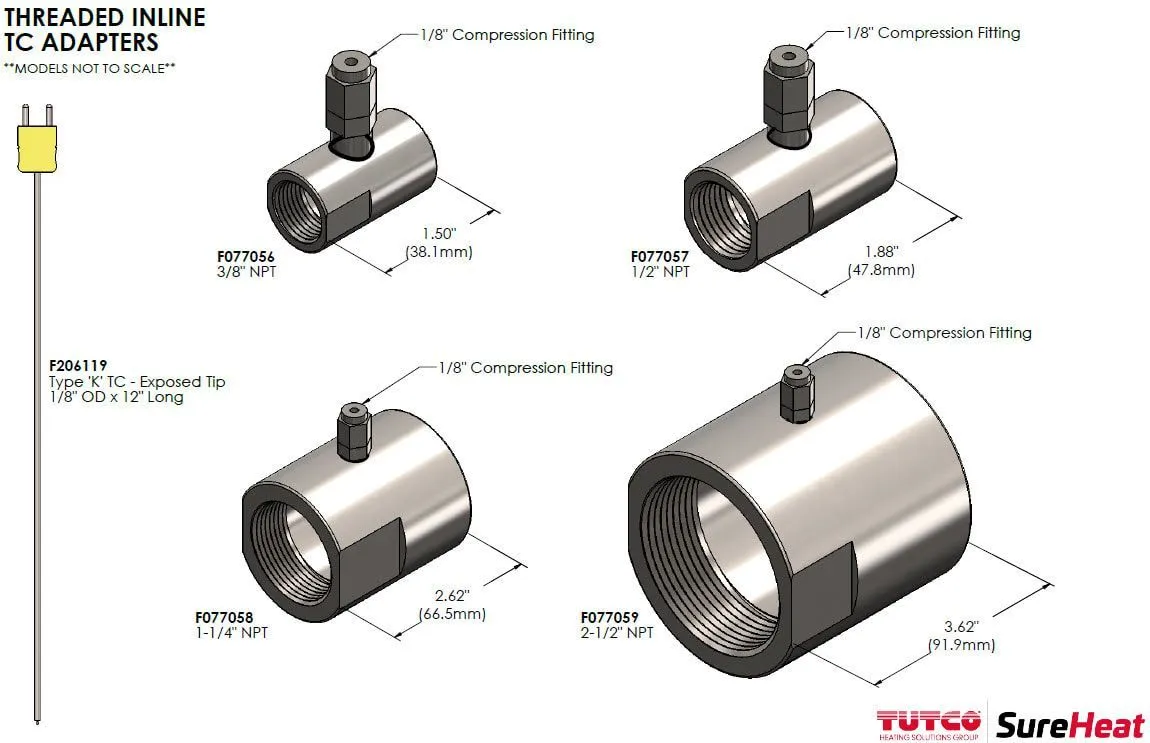
Comparison with Competitors
The Threaded Inline Heater’s robust design, high-pressure capability, and compatibility with digital temperature controllers make it an ideal solution for any process that demands precise, repeatable, and efficient high-temperature airflow, outperforming conventional heaters and other inline alternatives. TUTCO SureHeat Threaded Inline Heater offers several advantages:
- Higher Temperature Capability: Competitors like the Leister LE Mini offer maximum temperatures up to 900°F (482°C), whereas the SureHeat model reaches 1,400°F (760°C), providing greater flexibility for high-temperature processes.
- Leak-Proof Design: The Style A configuration of the SureHeat heater ensures a sealed electrical feedthrough, preventing leaks in sensitive or pressurized systems, a feature not commonly found in competitor models.
- Durability: Constructed from 304 stainless steel, the SureHeat heater offers superior corrosion resistance and longevity compared to some competitors that may use less durable materials.
- Pressure Rating: With a maximum inlet pressure of 150 PSI, the SureHeat heater is suitable for high-pressure applications, whereas many competitors are rated for lower pressures.
- Versatility: Available in multiple NPT sizes and power options, the SureHeat heater can be tailored to specific application requirements, offering more customization than some competitor models.
Controllers
Closed-Loop (Feedback) Control
Closed-loop heater control systems use a power controller, temperature controller and thermocouple to monitor and provide a constant output temperature, regardless of changes in airflow. The typical temperature controller provides a convenient display of the air temperature. (not the element temperature)
Power Controller
SCR (Silicon Controlled Rectifier) power controllers provide the smoothest power regulation for electric air heaters. Power controllers, such as SSR (Solid State Relays) or other fast-switching controllers are also used with our heaters. Contact TUTCO SureHeat for details.
Temperature Controller
Use only digital temperature controls with Type K thermocouple inputs. The temperature control output must match the input of the power control (i.e., 4-20mA or 0-10VDC). A standard PID-type control with a wide proportional band setting will work best to minimize temperature overshoot. PID parameters may be auto-tuned, but only at temperature specifications below the maximum of the heater. Monitor the heater temperature rise and turn power off immediately if it rises above the heater specification during the auto-tune cycle. Thermocouple Use only a fine wire (0.030” max. wire diameter), exposed junction, Type K thermocouple placed within 1” of the heater exit for accurate temperature readings. Other thermocouple styles, or varying the distance from the heater exit, will result in temperature measurement errors and thus the potential for heater failure
Why choose TUTCO SureHeat
Industry Expertise: With decades of experience in industrial heating solutions, TUTCO SureHeat is a trusted name in the industry.
Reliable Performance: Our heaters are designed for consistent, repeatable results, ensuring quality and efficiency in your processes.
Comprehensive Support: We offer technical support, custom solutions, and integration assistance to meet your specific needs.
Global Reach: Our products are used worldwide, providing proven solutions in various industries.
The TUTCO SureHeat Threaded Inline Heater stands out in the market for its high-temperature capability, leak-proof design, and durable construction, making it an excellent choice for industrial applications requiring precise and reliable air heating. Whether you're integrating it into OEM equipment or using it in standalone applications, this heater offers the performance and versatility needed to meet your heating requirements.
Frequently Asked Questions
The Threaded Inline Heater is versatile across automotive, aerospace, plastic processing, electronics, food & beverage, medical, and printing industries. Applications include adhesive activation, composite curing, shrink fitting, solder reflow, sterilization, and heat shrink wrapping. Its high-temperature performance, pressure capability, and robust stainless steel construction make it ideal for OEM machinery, production lines, and standalone systems.
Yes. The Threaded Inline Heater is compatible with digital controllers featuring Type K thermocouple inputs, enabling precise, repeatable temperature regulation. Proper thermocouple installation is critical—ensure the TC is positioned slightly above the ceramic rod and in the heated airflow for accurate readings.
Selecting the optimal heater depends on your temperature, pressure, and mounting requirements. Use the NPT size, power rating, and control compatibility to guide your choice. Style A is preferred for high-pressure, high-temperature systems, while Style B is suited for lower-temperature or flexible installations. TUTCO SureHeat experts can help match your process requirements with the ideal heater.
Style A features a leak-proof power feedthrough, supports inlet temperatures up to 900°F (482°C), and is ideal for pressurized systems. It uses nickel-plated terminal posts for secure electrical connections.
Style B offers flexible wire leads for easier installation, supports inlet temperatures up to 200°F (93°C), and is suitable for general applications. This style may leak a small amount of air through the wires. Both styles are rated for pressures up to 150 PSI.
